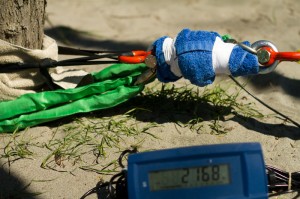Destructive testing
 Today marks the first installment in our “destructive testing” series. The purpose of this series of posts is to investigate what happens when stuff breaks, and how much force it takes to make stuff break. Safety is my number one concern, and my hope is that these experiments will help everyone to better understand how to stay safe.
Today marks the first installment in our “destructive testing” series. The purpose of this series of posts is to investigate what happens when stuff breaks, and how much force it takes to make stuff break. Safety is my number one concern, and my hope is that these experiments will help everyone to better understand how to stay safe.
Today I wanted to simulate the worst-case-scenario of slacklining: a highly questionable sling blowing out (sending hardware flying). The most questionable webbing I had laying around was a piece of black webbing I’d been using as a dog leash, until my dog chewed one end off. I bought this webbing from Aron over 2 years ago, and who knows how long he had it. Among its many problems:
- More than one partial cut (from my dog chewing on it)
- A loop sewn haphazardly in one end
- A loop tied in the other end with a crappy overhand knot
Basically I wouldn’t trust this sling to support a 350lbs-of-tension 20ft line, let alone anything that involved pulleys. For those who are concerned about safety of this experiment, everything in my rigging (besides the horrible sling) was rated for 10,000+ lbs, and you can see the green spanset (10,600lb working load) rigged so that when the sling blows it will almost immediately snap tight. After 1:15 you can see the sling really begin to stretch. Even with the horrible wind, at 1:27 and then again at 1:30 you can hear the worst cut in the line tearing open.

What did you use to pull the line so tight? Just a bunch of people?
Expand and become West Coast Slackline!
James – Davis CA
ANSWER: SBI 5:1 pulley system, ascender with pulley multiplier, Petzl ID for brake, and myself. I forgot to bring my second set of ascenders for a double multiplier, so I maxed out at 2500lbs. Next time I’ll be able to do ~4000 by myself.